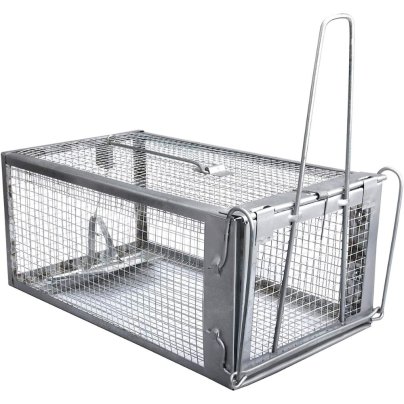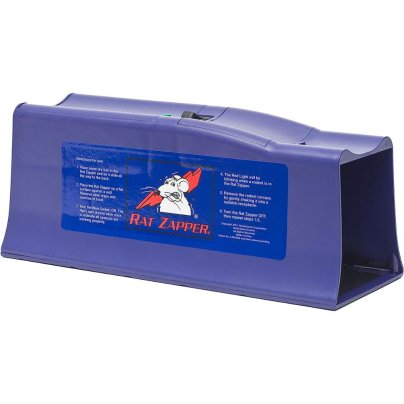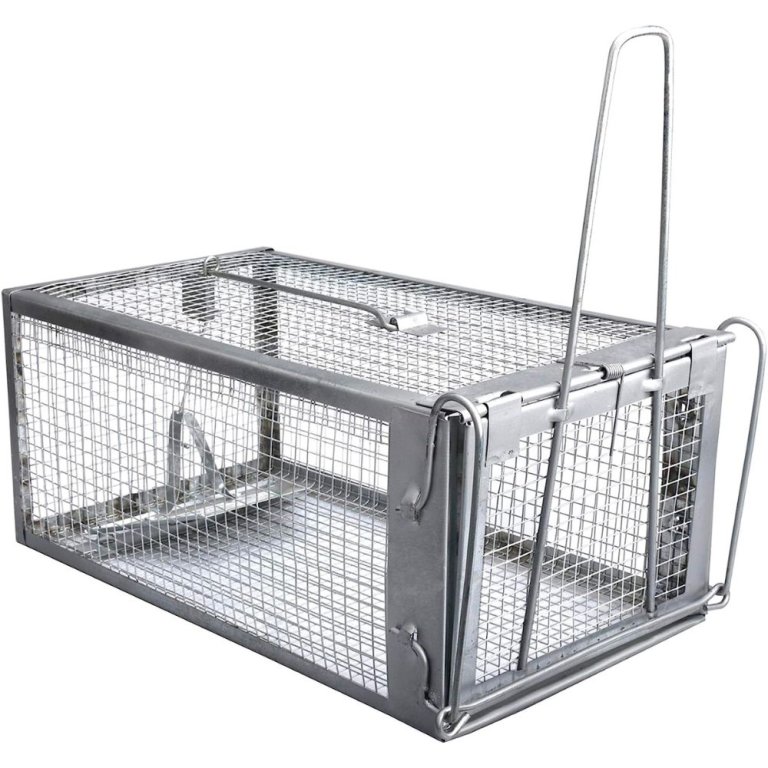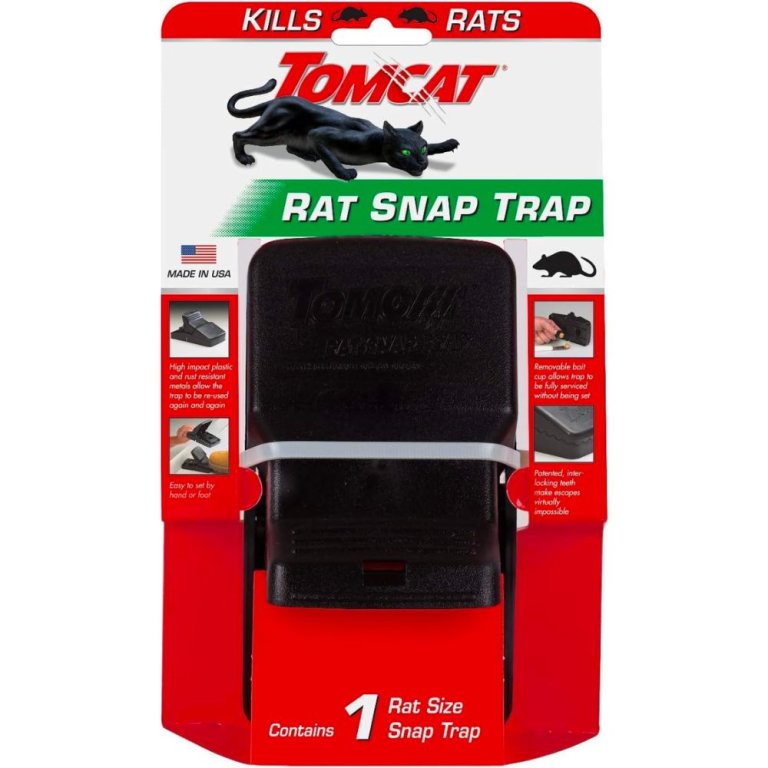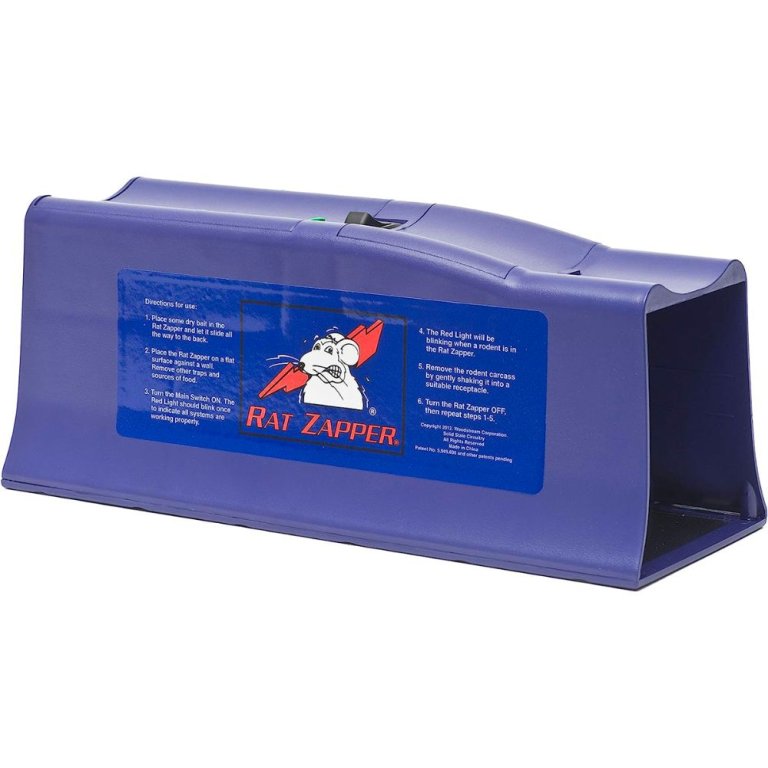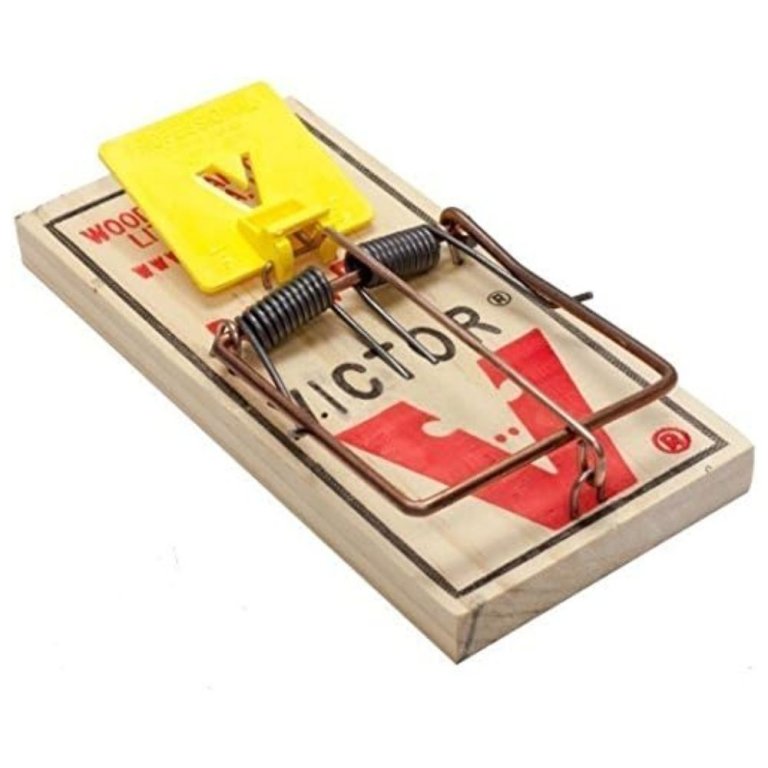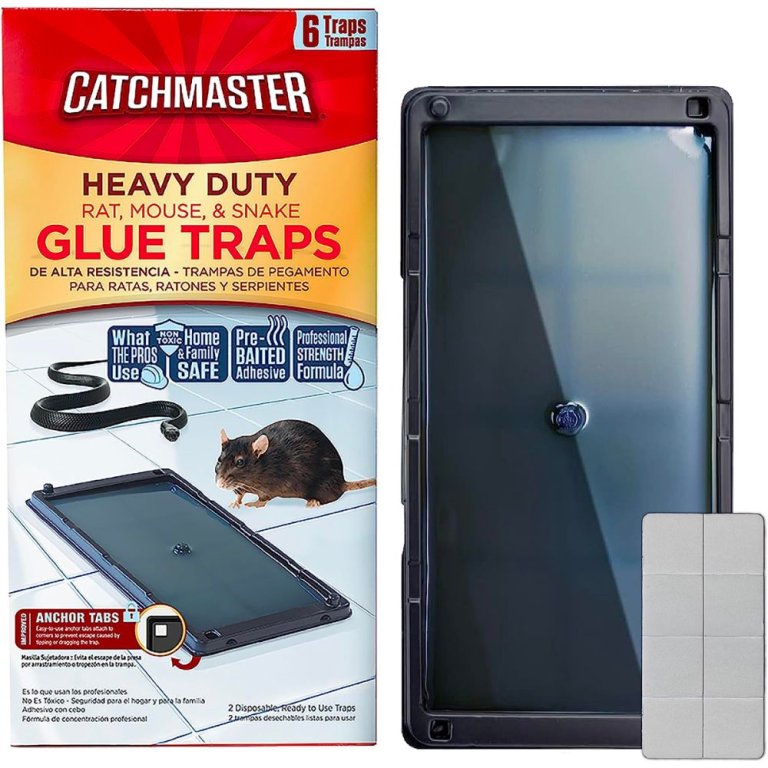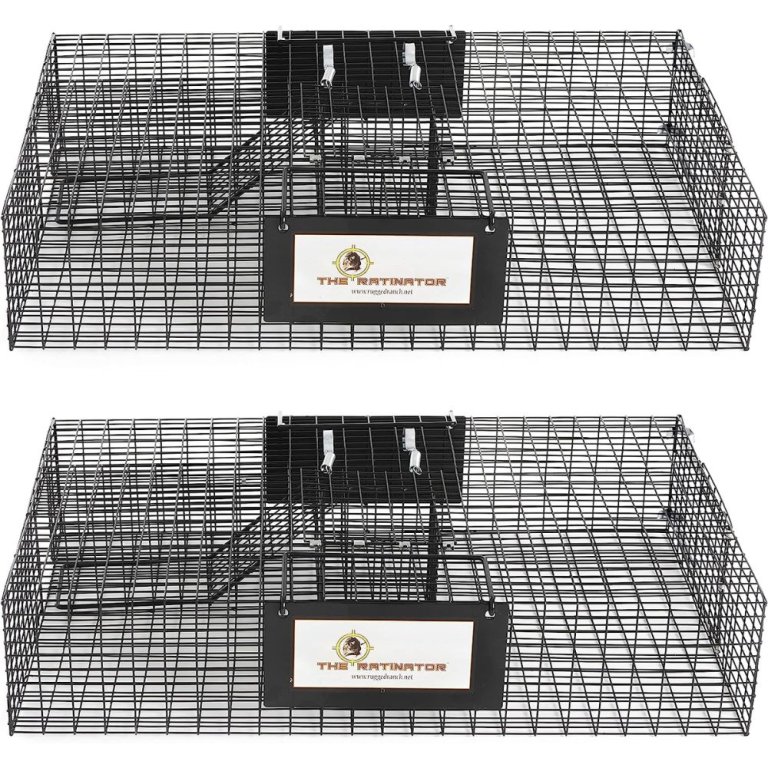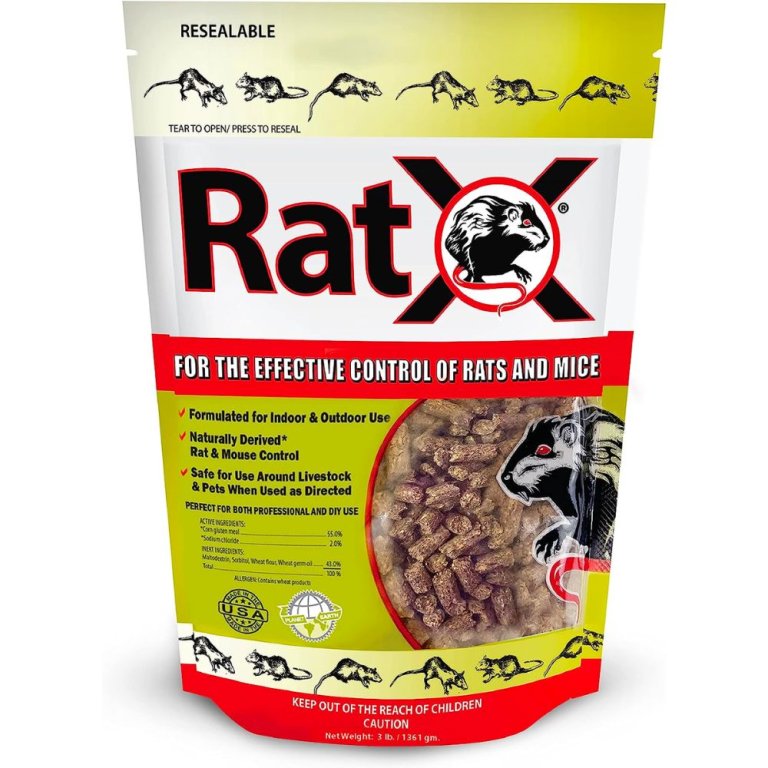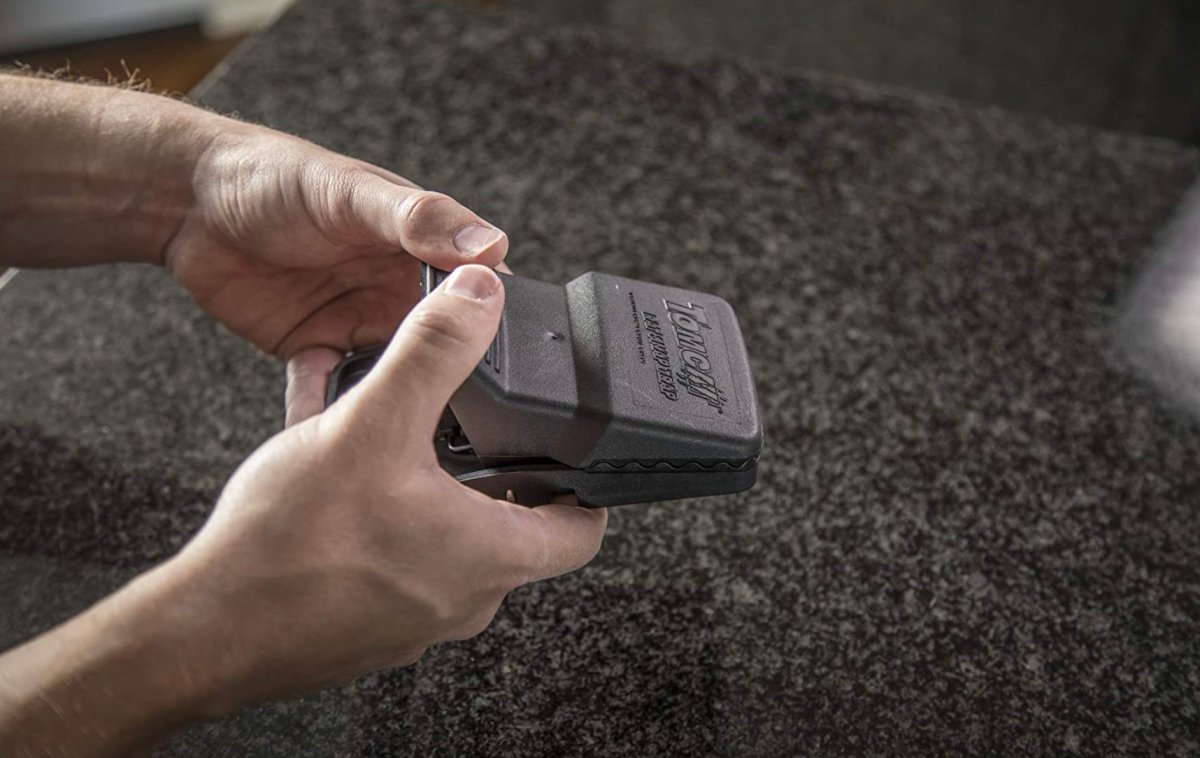
We may earn revenue from the products available on this page and participate in affiliate programs. Learn More ›
If you see tiny droppings in the cupboard and hear scratching noises in the walls, you may have a rodent problem. Mice and rats invade some 14.8 million U.S. homes each year, according to the U.S. Census. Rats infiltrate food supplies, make nests in closets, and open the home up to a host of health risks.
With about 1 out of 10 American homes reporting having seen a rodent in their residence at some point in the past year, the good news is that there are plenty of options for combating this invasion. Manufacturers offer many effective solutions—both lethal and nonlethal—to solve a rodent infestation problem.
Read on to learn more about rodent control methods, and don’t miss our list to find some of the best rat traps on the market to suit your needs.
- BEST OVERALL: Gingbau Humane Rat Trap
- BEST BANG FOR THE BUCK: Tomcat Rat Snap Trap
- BEST ELECTRONIC: Victor Rat Zapper Classic Rat Trap
- BEST WOODEN: Victor Wide Pedal Rat Traps
- BEST GLUE: Catchmaster Heavy-Duty Rat & Mouse Glue Traps
- BEST FOR MULTIPLE RATS: Rugged Ranch Ratinator Rat Trap
- BEST NONTOXIC BAIT: EcoClear Products RatX Pellets
- BEST KID-SAFE: UCatch SuperSafes Dual-Entry Rat Trap
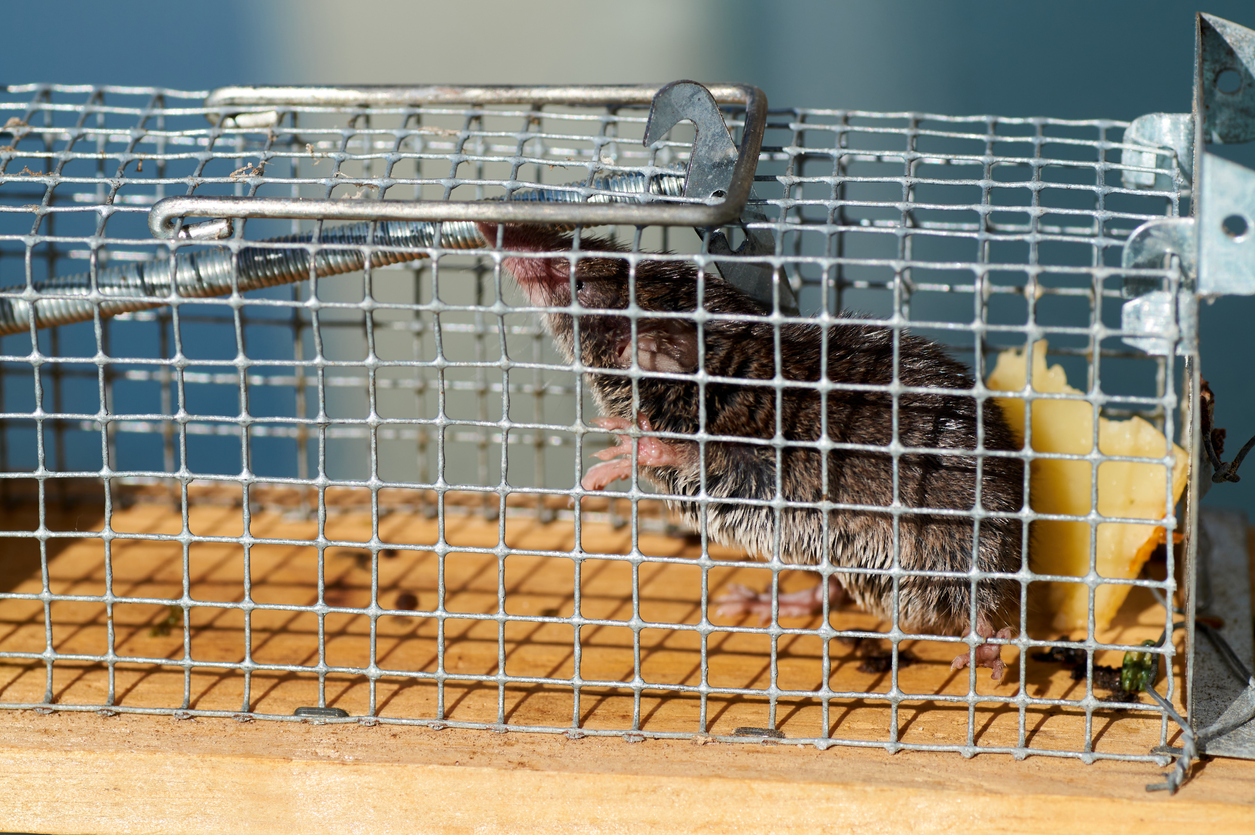
How We Chose the Best Rat Traps
To help guide our research, we reached out to several pest control experts to get their professional advice on the best types of traps to consider. Tim Sherrer, owner of Expest Exterminating in Athens, Georgia, says, “Identification of the type of rat or rodent is very important when considering control options. Larger rats will require a heavy-duty snap trap, while glue boards may not hold a larger rat.”
With this in mind, our curated list of rat traps covers the range of trap types available in the market, including glue, snap, catch-and-release, bait, and electronic traps and zappers. We looked at several contenders in each category to find the best in their respective fields in terms of performance, ease of use, and price.
All of our recommendations are among the most effective at their specific job, so this list provides shoppers with a faster way to find the style of trap that best suits their needs. We made sure to provide solutions for a range of infestation sizes, as well as options for those who prefer a more humane way of dealing with rats.
We know that dealing with and disposing of dead rats is certainly not a job for everyone, so we have included a few picks that keep the rodents out of sight and can be disposed of without touching or seeing them.
Lastly, we spoke with Nicole Carpenter, president of Black Pest Prevention in Charlotte, North Carolina, who provided an expert’s insight on which type of bait is best to use once you’ve decided on the type of trap. “The best baits are those that are both enticing and require some effort to remove, like peanut butter, soft cheese, or a small piece of hot dog, which will stick to the trigger plate, making it more likely to activate when eaten. Ensure the bait is securely attached so that rats can’t nibble it off without springing the trap.”
Our Top Picks
Our list of top-performing products addresses typical household rodent problems using both lethal and nonlethal methods, including traps from some of the best-known names in the pest control industry.
Best Overall
Gingbau Humane Rat Trap
Pros
- Simple setup; suitable for novices as well as professionals
- Easy to clean; the metal build allows for wiping or rinsing
- Lightweight and easy to transport if required; ideal for animal rescues or pest control
Cons
- Trigger may not engage for smaller rats; may not be ideal for some users’ needs
Product Specs
- Type: Live-animal cage
- Disposal method: Catch and release
- Reusable? Yes
Catch live rats and mice, and then humanely relocate them with this trap from Gingbau. This model is constructed of a sturdy galvanized steel, making it ideal for outdoor use. Setup is easy with detailed instructions included for setting the trap. At 10.5 inches long, 5.6 inches wide, and 4.4 inches high, this trap is perfect for catching mice and rats. It’s not large enough to catch larger creatures, such as the neighbor’s adult cat, by mistake.
This cage includes a bait hook at the rear of the cage with a pressure-sensitive pedal under it. When the rodent applies weight to the pedal, it activates an arm bar, which causes the door to close and lock, trapping the animal. This reusable rat and mouse trap weighs less than 1 pound, making transporting the rodent easy.
Get the Gingbau rat trap at Amazon.
Best Bang for the Buck
Tomcat Rat Snap Trap
Pros
- Reusable design is ideal for household pest control as well as professional use
- Kills instantly; snap closure is effective and reliable
- Rats are highly unlikely to escape after the trap has been set off
Cons
- Requires manual disposal of the dead rat, which could upset some users
Product Specs
- Type: Snap trap
- Disposal method: Manual removal
- Reusable? Yes
When setting up outdoor traps, the target is likely something bigger than a mouse. This snap trap from rat-catching specialist Tomcat is a safe and easy-to-use indoor/outdoor trap capable of taking down rats. At 6 inches long, 4.25 inches wide, and 2 inches high, this Tomcat snap trap is big enough to handle larger rodents.
This trap uses a new snap style that has the appearance of an open set of jaws. Once the rat begins eating bait from the pressure plate, the jaws snap shut and suffocate the rat using a powerful spring.
Unlike traditional traps, the Tomcat Rat Snap Trap can be safely set by hand or foot without the need to put fingers in harm’s way. These rust-resistant metal and plastic traps are easier to clean than traditional wood versions.
Get the Tomcat rat trap at Amazon or Tractor Supply Co.
Best Electronic
Victor Rat Zapper Classic Rat Trap
Pros
- Considered a more humane method of getting rid of rats
- Dead rats is hidden from view; ideal for homes with pets or children running around
- User can dispose of rats without touching them for safety
Cons
- May be difficult to clean inside the trap after use
Product Specs
- Type: Electronic trap
- Disposal method: Hands-free; dead rat hidden from view
- Reusable? Yes
The rat won’t know what hit it with the Rat Zapper Classic. This tunnel-shaped trap is 12 inches long, 4.5 inches wide, and 4.3 inches high—roomy for larger rodents. When the offending rodent enters the tunnel and steps on the metal plates inside this trap, it completes an electric circuit that sends a high-voltage shock through its body for a quick and humane end.
This trap requires four AA batteries, which supply enough power to kill 20 rats. A convenient LED light flashes red to let users know when it has claimed a victim, and a kill chamber that allows a user to dump the rat without having to touch or even look at it, which makes disposal less cringe-worthy. This trap is suitable for indoor use only.
Get the Victor Rat Zapper rat trap at Amazon.
Best Wooden
Victor Wide Pedal Rat Traps
Pros
- Large pedal provides a lot of surface area for attracting and catching rats
- 2 settings to choose from; can be set to firm or sensitive depending on individual users’ preferences
- Environmentally friendly construction; wood is sourced from Forest Stewardship Council (FSC)–certified forests
- Can be reused if desired, or the rat can be thrown away with the trap
Cons
- May not be safe for homes with children and pets
Product Specs
- Type: Snap trap
- Disposal method: Manual removal or throw away rat and trap
- Reusable? Yes
Wooden rat traps may be a bit old-fashioned, but there is something to be said about an old reliable option like the Victor Wide Pedal rat trap. This two-pack of Victor rat traps is made with a wide pedal that snaps the trap closed at the first sign of motion, and the wood is made from environmentally responsible materials in the U.S. from FSC-certified forests. These wooden traps also have a firm or sensitive setting depending on the given user’s preference for rodent control.
Depending on the size of the property or rat activity, these Victor rat traps come in packs of two or four and are easy to set up. The only downside of these wooden traps is that they may not be safe for homes with children and pets running around.
Get the Victor Wide Pedal rat trap at Amazon, The Home Depot (12-pack), or Walmart.
Best Glue
Catchmaster Heavy-Duty Rat & Mouse Glue Traps
Pros
- Multiple traps included for effective household or professional pest control
- Effective up to 1 year for reliability and ease of use
- Comes with floor anchors to prevent pets or children from picking up the dead rats
Cons
- Manual and hands-on disposal method is not for the faint of heart
- Not reusable; may not be ideal for larger infestations
Product Specs
- Type: Glue trap
- Disposal method: Trap thrown away with the rat
- Reusable? No
These trays from Catchmaster include glue-style traps that are nontoxic and safe for use around children and pets. The powerful glue traps rats and mice that walk over them, allowing users to dispose of them later. Each pack includes six glue boards that are effective for up to 1 year, for long-term control of a rodent population without financial strain.
The Catchmaster glue traps can fold into a tunnel shape for dirty locations, allowing them to fit into tight places and prevent dust and dirt from collecting in the glue. Each trap is 10 inches long, 5 inches wide, and 0.5 inches tall. The Catchmaster glue trays are easy to use and even include floor anchors with heavy-duty putty to prevent rodents from dragging the tray and freeing themselves.
Get the Catchmaster rat trap at Amazon.
Best For Multiple Rats
Rugged Ranch Ratinator Rat Trap
Pros
- Ideal for large amounts of rat activity; capable of fitting 21 rats at a time
- Can also be used to kill rats; suitable for household and professional pest control
- Multiple hatches to dump rats out into the wild after caught
Cons
- Spring mechanism can weaken over time
Product Specs
- Type: Live-animal cage
- Disposal method: Catch and release
- Reusable? Yes
When there’s a rat infestation, standard rat traps that only catch one rodent at a time just won’t do. A bigger trap like the Ratinator may be better equipped for multiple trapped rats. This cage-style trap is 26.5 inches long, 16.5 inches wide, and 6 inches high, which is enough space to catch up to 21 rats in a single setting.
This nonlethal animal trap allows users to relocate beady-eyed captives to a location far from a home. Alternatively, for those less sympathetic to the plight of rats, the Ratinator comes with an air-tight plastic container that perfectly fits the entire cage. The Ratinator weighs just under 9 pounds, without any rat prisoners.
Get the Rugged Ranch rat trap at Amazon (2-pack) or Target.
Best Nontoxic Bait
EcoClear Products RatX Pellets
Pros
- Environmentally friendly and safe to use around pets (except gerbils) and children
- Large 3-pound bag is suitable for large and small infestations
- Causes rats to die within 2 to 4 days of ingestion
Cons
- Rats are not always attracted to the bait
- Should not be used in households with pet mice, rats, or gerbils
Product Specs
- Type: Nontoxic poison bait
- Disposal method: Standard
- Reusable? No (consumable)
For households with young children or pets, using poisonous bait isn’t a safe option for solving a mouse or rat problem. This nontoxic bait from EcoClear offers a safe choice. Although it’s safe for people, pets, and wildlife, it takes advantage of rats’ unique digestive systems.
Once they eat the bait, they lose the instinct to drink water, causing them to die of dehydration in 2 to 4 days. This rat bait comes in pellet form, allowing users to add it to bait trays. A 3-pound bag is enough bait to handle a moderate mouse or rat problem. Because this bait is nontoxic to all but rats and mice, it is safe to use indoors.
Get the EcoClear Products rat pellets at Amazon.
Best Kid-safe
UCatch SuperSafes Dual-Entry Rat Trap
Pros
- Dual-entry model is ideal for placing in tight crawl spaces where rats tend to scamper
- Made with a covered-tunnel design to keep children and pets away from the jaws and bait cup
- Integrated lever allows the trap to be set easily and for dead rodents to be disposed of hands-free
- Precision trigger and steel spring integrated for effective and reliable use; suitable for long-term reuse
Cons
- Some users have reported limited durability; may not withstand outdoor use
Product Specs
- Type: Snap trap
- Disposal method: Manual disposal
- Reusable? Yes
Children and pets running around the house is fun and wholesome. But rats running around with them can be hazardous. To ensure all pests are caught without harming little paws and hands, trust the UCatch SuperSafes rat trap. This dual-entry trap is designed with a covered tunnel design that keeps the snap trap jaws and bait cup out of reach while remaining large enough for a rat to enter the trap. This model is also made with a precision trigger and steel spring for effectively killing on contact.
The integrated lever is also easy to use when setting the trap and disposing of the dead rodent. Simply push the lever down and release the body and place again for reuse. Finally, this model comes in a pack of two or four depending on the size of the infestation or property.
Get the UCatch rat trap at Amazon.
Jump to Our Top Picks
What to Consider When Choosing a Rat Trap
When selecting the best rat trap, it’s crucial to consider a few factors, including where it will be used, the size of the rodent population, and whether the goal is to catch or kill these four-legged intruders.
Types of Rat Traps
Below, learn about four basic varieties of rat traps—snap, glue, live animal, and electronic—to determine which type will work best for your rodent problem.
Snap Trap
This is the old-school rat trap that consists of a thick metal wire attached to a small piece of wood. A spring-and-catch design allows users to set the trap. A bit of bait is placed on a small portion of metal attached to the catch. When the rat takes the bait, the catch is released, causing the metal part to snap shut on the rat’s head, breaking its neck and killing it instantly.
While these traps are cheap and effective, they are also potentially dangerous. Depending on the trap’s size, a snap trap can hurt or even break fingers, making them unsuitable for use in homes with young children.
Safer plastic snap traps work by suffocating their furry victims. This type of trap uses a mechanism that resembles the open mouth of a snake. When a rat wanders into these plastic jaws and takes the bait, the mouth clamps shut, applying pressure on the rat and suffocating it.
This type of trap is better for homes with children, as the closing mechanism isn’t forceful enough to injure fingers or toes like a traditional wire mousetrap. These traps are reusable but do cost more than standard snap traps.
Glue Trap
Glue traps are one of the most effective and controversial ways of catching a rat. A glue trap consists of a flat plastic board covered in extremely sticky glue on one side. Users place rat traps in an area with rat activity. When the rat scampers over the board, it becomes stuck in the adhesive, which immobilizes the animal. The more it struggles, the more trapped it becomes.
This type of trap is not the recommended solution, since most people consider them to be inhumane. The trap does not kill the animal immediately, resulting in a slow death from dehydration or starvation. Glue traps also collect dust, dirt, and even insects, eventually rendering them ineffective. They also cannot be reused.
Live-Animal Trap
Cage traps are a nonlethal option and are the most humane way of dealing with a rat problem. Live-animal traps consist of a small cage. When the rat is lured into the cage by bait, it steps on a pressure-sensitive trip plate, triggering a spring mechanism that causes the cage’s door to snap closed, trapping the rat.
Then, the animal can be relocated to an area far enough away that it won’t return, which typically involves a car trip. Live-animal traps are larger and more expensive than other trap types. It’s possible to also inadvertently trap other small animals.
Electronic Trap
This more humane form of lethal rat trap involves a high-voltage shock. This tunnel-shaped trap includes one or more bait traps along its back wall to lure the rat inside. The interior of the tunnel consists of a metal plate on the floor. Once the plate senses pressure, it delivers a charge of 7,000 volts, killing the rat instantly.
Electric rat traps typically use four C batteries, about the same amount of power required for some battery-powered children’s toys. The shock isn’t strong enough to harm children or larger pets such as dogs and cats.
Indoor vs. Outdoor
Some traps are designed for only indoor or outdoor use.
- Traditional snap traps do not fare well outside because of their wood construction. If left to weather, the wood can warp, ruining the trap’s trigger sensitivity.
- Due to their propensity to collect dirt and debris, glue traps are only suitable for indoor use. Electronic rat traps are not weather-resistant. Exposure to rain could cause them to short out or malfunction.
- Cage traps, which typically feature galvanized steel, are suitable for outdoor use. It’s important to keep in mind that wildlife and neighborhood pets may inadvertently be affected by outdoor traps.
- Newer plastic snap traps can withstand outdoor weathering, making them good options for use outside the home.
Kill vs. Catch-and-Release Traps
The decision to use a kill or catch-and-release trap comes down to how you feel about rats. Do you see these creatures as misguided furry critters, or as disease-carrying menaces?
Those who believe killing these rodents is inhumane can consider a catch-and-release option. Just keep in mind that catch-and-release traps require the extra step of transporting the animal to another location so it does not return. However, it’s possible to inadvertently release that rat on someone else’s property, which presents a whole other ethical dilemma.
If conflicted, keep in mind that some traps offer a more humane way of killing than others. In fact, Nicole Carpenter shared her expert advice on how to use a cage trap effectively: “Place a cage or live catch trap in the areas near your home where you have noticed rat activity and monitor it. When there’s a rat in the trap, you need to release it far from your home, ideally well away from your neighborhood.” She adds that to be as humane as possible, these traps also require “regular monitoring to avoid causing stress and harm to the captured rat.”
Number of Traps
Ridding a home of its rat or mouse population can be a frustrating process. Although many of these traps have been around for decades, they don’t always work. One problem may be the number of traps being used. Pest companies recommend three traps for every rodent. If there are five mice inhabiting a home, that means 15 traps will be needed to put an end to the infestation.
Single vs. Multi-Rat Trap
Single traps work well for handling smaller problems of fewer than 10 mice. Just remember that most experts recommend three single traps per rodent to eliminate a rodent population.
Multi-rat traps, such as the famous Kness Ketch rat trap invented 100 years ago, can catch up to 15 mice in one setting—meaning users need to set this trap only once to catch multiple mice.
These traps are mainly used in commercial locations that have more significant mice and rat problems. These nonlethal traps work well if there is a large number of rodents inhabiting a home. Users will need to keep in mind that they’ll need to dispose of these live animals once they’re trapped. For larger infestations, consider calling in the pros.
Disposal Method
Disposing of rat corpses can be understandably unpleasant. For example, the classic snap trap requires a user to manually remove the corpse in order to reuse the trap. Glue traps make disposal easier—all the user needs to do is simply pick up the whole trap and throw it away. However, this disposable design requires replacing the trap with a new one after every kill, which can get costly if there’s a large rat population.
Some newer designs allow the user to dispose of the rat without having to touch the dead rodent or even look at the corpse. These traps kill the rat in an enclosed space and use an external indicator to let the user know when it’s full. To dispose of the body, simply tip the trap over the garbage. This is a more attractive option for the faint of heart and still allows reuse of the trap.
Safety
Safety is undoubtedly an issue when it comes to rat traps. If there are children or pets in the home, safety is especially important when shopping for a rat trap.
The classic snap-style traps are dangerous, and users should take care with their rat-trap placement. Smaller ones can painfully snap the fingers, while larger ones can break bones.
Some use poison bait to kill rats, which is toxic to humans and pets. Glue traps, electric shock traps, and nontoxic bait offer safer alternatives.
Ease of Use
Some traps are easier to set and use than others. The classic snap trap requires some skill to set properly and to ensure users don’t snap themselves. Plastic snap traps and electric traps feature designs that make them much easier to set, while glue traps simply require removing a protective cover for use.
FAQs
If you still have gnawing questions about rodents, read below to get answers to some of the most common concerns about rats.
Q. How do you know you have a rodent infestation?
Since rats and mice are not particularly hygienic creatures, there are many signs that indicate an infestation:
- Droppings and urine are present. This is the most telltale sign. Mice and rats aren’t the cleanest of houseguests. Rat droppings and urine stains are sure signs that rodents have taken up residence in a home. The more droppings you see, the more mice or rats there are to be living in the home.
- You see gnawed holes on things like baseboards, wood trim, cabinet doors, and packaged foods. Rats and mice will chew through all kinds of materials to get to food. If you find gnawed holes in areas throughout your home, you likely have a rodent problem.
- You hear sounds in the walls and ceilings. If you hear scampering noises in your walls or ceiling, your house probably isn’t haunted; you likely have mice.
- Your pet is displaying odd behavior. Your pets and their heightened sense of hearing and smell will pick up on these rodent visitors before you do. If Fido or Fluffy seems to be hearing or seeing things you don’t, it could be mice or rats in your home.
Q. What attracts rats to your house?
Rats spend most of their lives hunting down the next meal, and humans are a great source of food. The first thing they’ll detect is your garbage. From there, they’ll move to other food smells coming from inside your home. Nip things in the bud by preventing rats from getting into your garbage. Make sure your garbage cans have tight lids.
Q. Do rats learn to avoid traps?
Rats are inherently suspicious creatures; it’s a survival mechanism that has evolved in rodents. They will avoid objects new to their environment until enough time has passed that these items become familiar. This is why it may take some time before the traps you just put out begin to bear fruit.
Q. What kills rats instantly?
Many people think poison will kill rodents quickly. Poison is one of the slowest methods for killing rats, as it takes at least 3 days for it to kill the rodent once it’s ingested. Snap traps will break a rat’s neck, and electric traps, which deal a lethal shock to rodents, will instantly kill rats.
